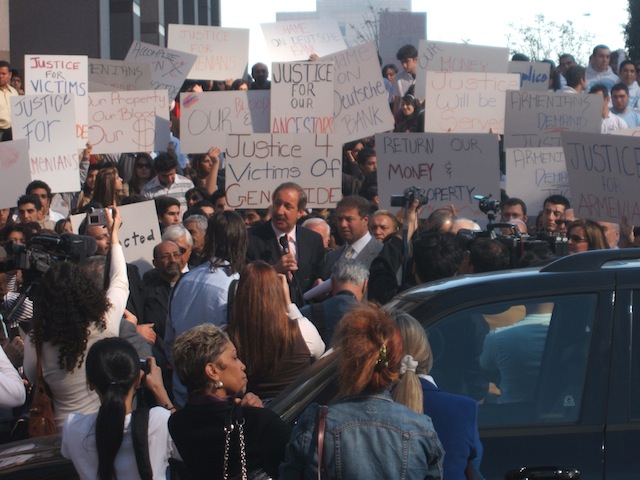Insurance Reparations

Mark Geragos, with hundreds of AYF members during a press conference, announcing impending lawsuit, in front of Deutsche Bank
We all know about the atrocities that occurred during 1915-1923. What we do not know is what happened to all the money and property the victims of the Armenian Genocide lost.
Throughout the years following 1915, the victims and their families were not necessarily worried about acquiring their lost wealth but more of escaping the memories of the slaughter of their loved ones along with the trauma of being exiled from their homeland. However, one woman, Yegsa Marootian, was brave enough to stand up and claim her lost assets.
Upon arriving to New York in 1920, Yegsa went to the New York Life insurance company and filed a claim as the beneficiary of her murdered brother’s insurance policy. Unfortunately, she was turned down because she could not provide a death certificate and because the statute of limitations on her claim had run out. She was denied and offered zero compensation.
Seventy-nine years later, Martin Marootian, Yegsa’s son, sued New York Life along with dozens of other plaintiffs for not giving the insurance claims of the Genocide victims who fell in 1915. They demanded the list of Armenian life insurance policy holders and compensation by New York Life to the heirs.
Once this lawsuit began to garner attention, Adam Schiff along with 13 other cosponsors introduced H.R. 3323: The Armenian Victims Insurance Fairness Act. This Act was to “permit States to require insurance companies to disclose insurance information.” Though the bill never became law it did make a point to the insurance companies to compensate these victims and their families for their claims.
After years of negotiations the lawsuit was finally settled. New York Life was to give $20,000,000 in insurance reparations to the beneficiaries; $4,000,000 would go to the lawyers and $3,000,000 would go to various Armenian social service agencies.
Even though New York Life has given the money they owed to the Genocide victims and their beneficiaries, there are still many other banks and insurance companies who owe these victims their lost wealth and fortunes. Following the New York Life case, the firms in the forefront of the insurance lawsuit—Kabateck Brown Kellner LLP, Geragos & Geragos, and Vartkes Yeghiayan & Associates—filed and won a similar $17 million settlement from AXA for unpaid life insurance benefits. They currently have several other lawsuits pending against companies who usurped assets from the Genocide.
These victories demonstrate the value of pursuing justice through the court system and being vigilant, not just against Turkey, but all those who reaped benefits from the victims of the Armenian Genocide. They have proven in concrete terms that there are other avenues for justice parallel to and beyond the important task of gaining Genocide recognition.
Editor’s note: Although the New York Life lawsuit resulted in a positive settlement, much more research is needed in the realm of quantifying genocide-era losses—be they life, property, or territory in order to reach proper settlement.


Leave a Reply
Want to join the discussion?Feel free to contribute!